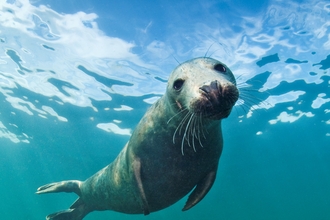
How to watch seals on Scilly
See Scilly's iconic grey seals
Seal spotting is a fun and exciting way to engage with one of Scilly’s most iconic species. Grey seals can often be seen bobbing off the coastline or in the embrace of an inlet, appearing almost like buoys in the water. We only have one breeding species of seal around the Isles of Scilly, but on occasion rarer species turn up, including the odd common seal and even a walrus!
Occasionally grey seals will swim close to shore, allowing us to catch a closer glimpse at their surprisingly large size and curved, roman noses. Seals can be seen on Scilly all year round, although a good time to see them is during the breeding season, which lasts between the months of August and December. You can see them in many of the bays and on the beaches around Scilly, but the best chance to see them is to head out on a WiSe-accredited boat trip to see them. We recommend taking a Wildlife Safari with St Agnes Boating.
Females will haul themselves onto remote beaches to have their pups (usually on the Western Rocks, Annet or the Eastern Isles), and are known to leave their pups on the shore in order to feed. They will also haul themselves onto rocks and beaches to rest and digest their food, and it’s important to give them space during this time. Binoculars are ideal for watching seals safely from a distance, especially when walking along the coast. Individual seals can be identified in photos by the unique patterns on their fur. Check sheltered bays and rocky outcrops, including Pelistry on St Mary's, Great Bay on St Martins and Great Par on Bryher.
If you are watching from a boat, keep noise to a minimum to avoid scaring them into the water, staying 100m away at all time. Signs of a disturbed seal include restless behaviour, stampeding into the sea, 'tombstoning' (where they throw themselves from rocks into the water) and snarling. If you find a seal on a beach, it’s best stay clear and keep dogs on a lead (find out what to do if you find a seal pup).
Sharing the water with a wild seal is an exhilarating experience, but we are ultimately heading into their world and must show respect by letting them decide how close to us they want to be. Seals are curious by nature. They might follow behind swimmers in the water and may approach divers and nibble on clothing and equipment with their sharp teeth. Keep a good distance when snorkelling and kayaking and move away if the seals show any signs of disturbance. Heading out with a formal operator is the best way to experience swimming with seals. Though the seals will come very close, don’t try and touch them. They have a nasty bite and carry diseases, even when pups. Wild marine life should never be followed, chased, or fed.
Surveying Scilly's seals
We have previously worked with the Cornwall Seal Research Group on surveying on identifying grey seals around Scilly. To date, around 50 seals have linked the Isles of Scilly to Cornwall and Devon in England as well as to southwest Wales and northwest France each with a different visit pattern.
Through the surveys, we have identified a handful of seal celebrities. ‘Snowdrop’ is one of only three seals known to have pupped in Wales and England. 'Tick' is a young adult male and was first seen on Scilly but he routinely commutes from the north to south Cornish coast around Lands End. ‘Back r’ commutes to North Cornwall and back to Scilly, whilst Triangle Lobster (first identified on the Isles of Scilly) visited France before pupping on the Lizard the following year.
These celebrities will help us all to create shared resources to enable people of all ages to discover the amazing secrets of our charismatic seals.
Find out more
Find out more about Scilly's grey seals and how you can help them below.



